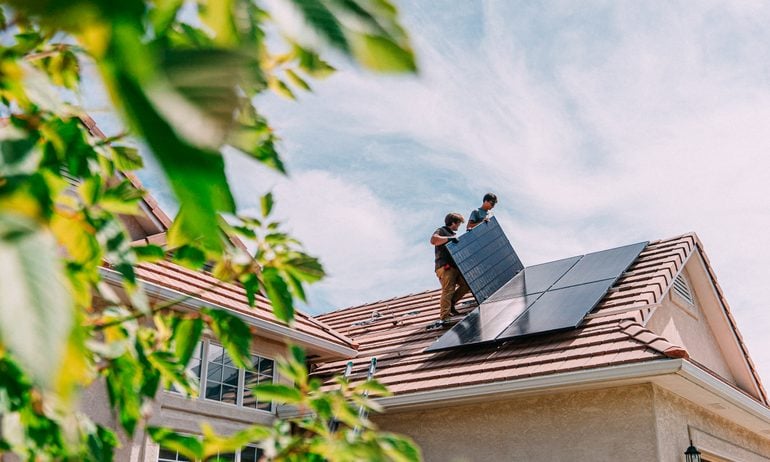Pros and Cons of Solar Panels: Worth It or Not?
Solar can cut utility bills and carbon footprints, but be sure you can afford the installation and have the right roof.

Some or all of the mortgage lenders featured on our site are advertising partners of NerdWallet, but this does not influence our evaluations, lender star ratings or the order in which lenders are listed on the page. Our opinions are our own. Here is a list of our partners.
A solar panel is a device that helps convert sunlight into electricity. The pros of using solar panels include a lower carbon footprint, lower electric bills, potentially higher home value and tax credits. The cons include high initial costs, specific roof requirements, possible higher property taxes and storage costs.
According to the U.S. Energy Information Administration’s 2020 Residential Energy Consumption Survey, the majority of energy use in American homes goes toward seasonal heating and cooling. However, only about 5% of residential sector energy end use in 2020 came from renewable sources like solar.
Solar power has become more affordable over time, and it offers communities and homeowners the opportunity to switch to a more sustainable, renewable and abundant energy source. Every home and every community is different, however. There are plenty of pros and cons to consider.
» MORE: Best solar companies of 2024
Pros of going solar | Cons of going solar |
|---|---|
Lower your carbon footprint. | Upfront costs. |
Save on your electric bill. | Not every roof will work. |
Increase your home value. | Potential property tax increase. |
Federal tax credits. | Solar storage expense. |
Advantages of solar panels
Nearly 4 million American households have switched to solar power. Here are a few of the benefits of residential solar panels.
Lower your carbon footprint
According to the Environmental Protection Agency, electric power generation was the second-largest emitter of CO2 in 2022. Solar energy systems do not contribute to air pollution or emit CO2.
The environmental impact of creating and installing solar panels is typically offset in one to four years, depending on the system. With a 30-year lifespan for most residential systems, this long-term environmental benefit could outweigh the short-term environmental cost.
Save on your electric bill
Switching to solar can reduce your monthly electric bill. How much you might save depends on how much power you use, the size of your system, if you buy or rent the solar panels, how much sun your roof gets and your local electricity rates.
With net metering, for example, the extra electricity your solar panels generate goes back to the power grid. The utility company then credits your account for that extra power, which is another way to help lower your electricity bill.
Increase your home value
Just like that nice chef’s kitchen with stainless steel appliances, solar panels can be a desirable upgrade for a lot of buyers. According to a 2019 survey by Zillow, homes with solar-energy systems sold for 4.1% more than homes without solar-energy systems. For median-value homes, that meant an extra $9,274.
Federal tax credits
The federal government offers a 30% tax credit on the total cost of installing solar panels on your home between 2022 and 2032.
Check for state tax credits and rebates from your utility provider or solar installer for additional savings.
Disadvantages of solar energy
It’s not always sunny switching to solar energy. Here are a few of the disadvantages of solar panels.
Upfront costs
The panels, inverter (which converts the sun's power into usable electricity), solar batteries for storing power, wiring and labor for a five-kilowatt (kW) residential system may cost anywhere from $10,000 to $25,000 or more.
Not every roof will work
The best roofs for solar panels face south, slope between 15 to 40 degrees and get direct sunlight for most of the day.
That doesn't mean you're out of luck if yours faces east or west; your solar panels might just generate less energy.
Certain roofing materials, such as cedar shakes, solar shingles or slate tiles, may be more difficult for installers to work with.
» MORE: How much do solar panels cost?
Potential property tax increase
Because property taxes are based on property value, an increase in your property’s value could raise in your property taxes.
Whether this will happen and how much the tax will increase depends on your state and local tax code.
Some state governments want to incentivize the solar switch by offering property tax exemptions for solar installations.
Solar storage expense
To power your home at night or on a cloudy day, when solar panels don’t generate much energy, you’ll need a solar storage battery. This comes with an extra cost. A solar-plus-storage system typically ranges from $25,000 to $35,000, depending on the size of the battery.
A separate solar battery system — if you already have the panels, but no storage — could cost anywhere from $12,000 to $22,000.
» MORE: Do solar panels work at night?
Who solar panels are best for
Solar isn’t the best option for everyone. A switch to solar energy might be a good fit for you if:
You own your home.
Your energy usage and monthly electric bill is high.
Your roof is unobstructed by trees or other structures and south-facing with a slope between 15 to 40 degrees.
You live in a state with net metering.
You qualify for state and federal tax incentives or rebates.
If you’re a renter or your roof isn’t suitable for a solar panel setup, you can still benefit from solar energy with community solar programs.
Can I get financing for a solar panel system?
In addition to tax incentives and rebates, there are options available. Many solar installers offer financing, but you may also be able to finance your solar investment through a home equity loan or home equity line of credit (HELOC). These options may have lower interest rates than financing with an installer, future opportunities for refinancing and possible tax benefits.
Home equity loans and HELOCs are ways to borrow against the value of your home, converting equity into cash. With a home equity loan, you receive a lump-sum payment and then pay it back at a fixed interest rate over an agreed period of time, typically from five to 30 years. HELOCs are more akin to a credit card, something you use as needed. You’ll usually have 10 years to draw from the line of credit, during which time you only have to pay interest, and after that you pay both the principal and interest. HELOC interest rates typically are variable, meaning your monthly payment could rise or fall over time. And with each of these options, you're using your home as collateral.
Another option is a solar loan. Many banks, credit unions and online lenders offer these to fund solar panels and installation, with amounts typically from $1,000 to $100,000, and annual percentage rates ranging from 6% to 36%. They function like a personal loan: you receive a lump sum and repay it in equal monthly installments over a set period, typically two to seven years. And unlike with home equity financing, there is no collateral required for a solar loan. This means your home or solar panels aren’t at risk if you miss payments, but you may have to pay late fees.
So, yes, you likely can get financing. If you go this route, compare interest rates, terms and fees with any financing package that a solar provider may offer you to ensure you get the best deal.






